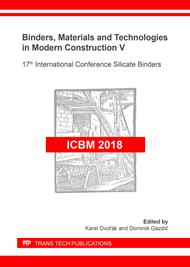p.41
p.47
p.57
p.64
p.73
p.79
p.85
p.93
p.99
Use of Lava Sand as an Alternative to Standard Quartz Aggregate in Lime Mortars
Abstract:
In this study, the utilization of lava sand as an aggregate in lime mortars, cement-lime mortars and natural hydraulic lime mortars has been investigated. The aim of this study is to compare some physico-mechanical and microstructural properties of lava sand mortars with reference mortars with pure quartz sand. Compressive and flexural strengths were tested at mortar age of 28, 56 and 90 days. The results revealed improved flexural strengths of mortars with lava sand despite the fact that the mortars showed higher open porosity and water absorption than those with quartz aggregate. This fact predetermines the use of lava sand in non-hydrophobic remedial mortars with a high ability to salt accumulation from masonry. The applied lava sand is convenient to lime-based mortars as an aggregate, especially in regions where the lava resources are abundant.
Info:
Periodical:
Pages:
73-78
Citation:
Online since:
August 2019
Authors:
Keywords:
Price:
Сopyright:
© 2019 Trans Tech Publications Ltd. All Rights Reserved
Share:
Citation:


